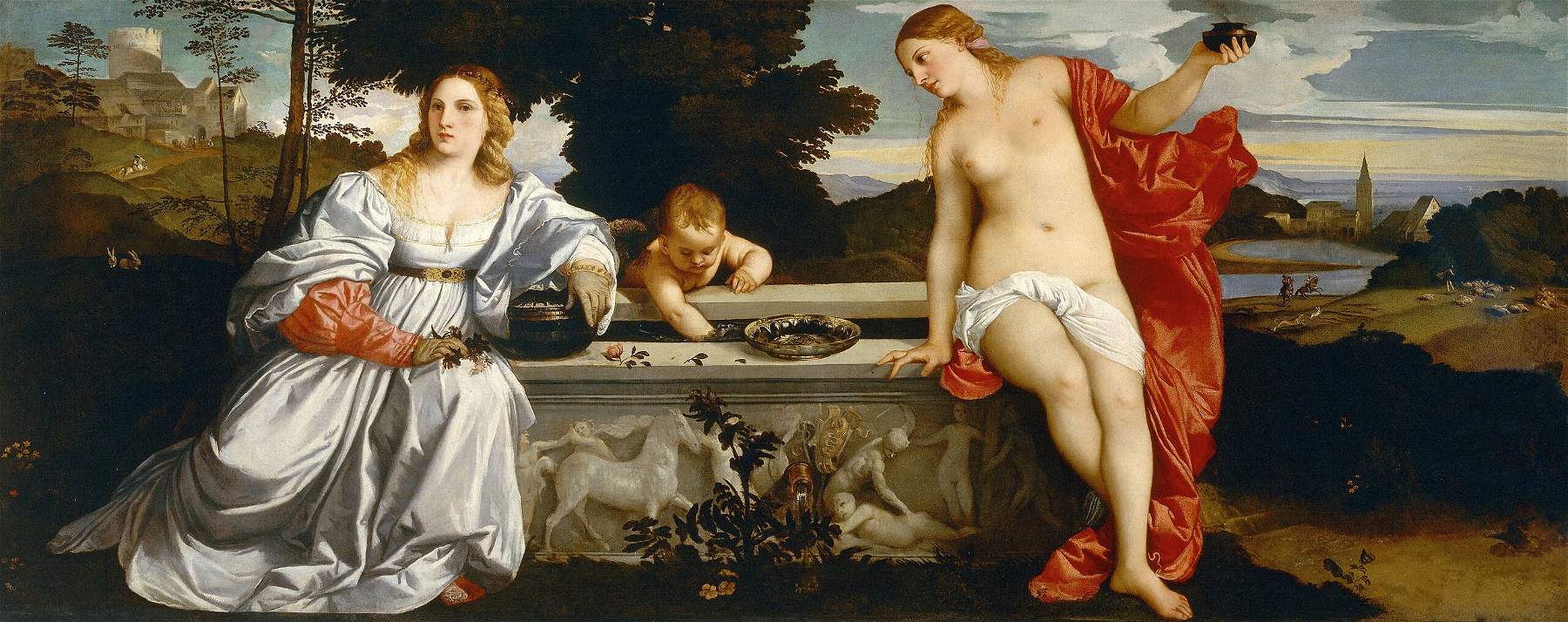The new SuperCult column launches today. Each day excerpts from criticism, art history or contemporary art, texts, descriptions, poems about art by historical and living authors.
The two women in Titian’s painting closely resemble a pair of personifications described and explained by Cesare Ripa under the title Eternal Happiness and Short Happiness: the “Eternal Happiness” is a young and beautiful blond woman of resplendent beauty, whose nakedness denotes her contempt for corruptible earthly things; a flame in her right hand symbolizes the Love of God. “Short Happiness” is a “lady,” whose yellow and white dress signifies “contentment.” She is adorned with precious stones and holds a vase filled with gold and gems symbolizing the vain and ephemeral happiness.

From this description we learn that at the end of the sixteenth century the juxtaposition of a naked woman bearing a flame [...] with a richly attired woman was understood as the antithesis between eternal and temporal values. As well, Ripa’s terms would not adequately define the content of Titian’s painting. “Eternal Happiness” and “Short Happiness” constitute a moral, or even, theological contrast just as irreconcilable as that painted in two French tapestries in the Musée des Arts Décoratifs, where a gentleman tempered by toil, self-mortification, faith and hope, and saved by God’s grace, stands in contrast to a lady who remains committed to worldly interests and associates with the blind Cupid. Titian’s painting, however, is not a document of neo-Medievalist moralism but of neo-Platonic humanism. Its figures do not express a contrast between good and evil, but symbolize a single principle according to two modes of existence and two degrees of perfection. The nude of elevated feeling does not despise the earthly creature whose seat she allows to share, but with a gentle and persuasive gaze seems to impart to her the secrets of a higher realm; and no one can overlook the resemblance, more than between sisters, between the two figures.
In fact, the title of Titian’s composition should read, “Geminae Veneres.” It depicts the “Two Twin Venuses” in Ficino’s sense, and with all the Ficinian implications. The nude figure is the “Heavenly Venus,” symbolizing the principle of eternal and universal, yet purely intelligible beauty. The second is the “Vulgar Venus,” and she symbolizes the “generating force” that creates the perishing but visible and tangible images of Beauty on earth: humans and animals, flowers and trees, gold and gems and works warped by art or talent. Both are therefore, in the Ficinian expression, “honorable and worthy of praise, each in its own way.”
That Cupid is placed between two Venuses, although somewhat closer to the “terrestrial” or “natural” one and stirring the water of the fountain, may express the Neoplatonic belief that Love, the principle of “cosmic mixture,” acts as an intermediary between heaven and earth; and the very fact that Titian’s fountain is an ancient sarcophagus, originally intended to hold a corpse but now converted into a pulpit of life, can only underscore the idea of what Ficino had called vis generandi.
Titian did not necessarily need to explain his “Amor sacro e amor profano” by means of a learned Latin poem. Even ignoring its correct title, “Geminae Veneres,” one can understand the picture, and it is the learned, rather than the naive observer, who finds its interpretation arduous.
---
Erwin Panofsky, Studies in Iconology (transl. it. Renato Pedio), Einaudi, Turin, 1975 [first published in original language: Oxford University Press, 1939], pp. 205-211
For more information on Titian’s work.
 |
| Supercult. Erwin Panofsky on Titian |
Warning: the translation into English of the original Italian article was created using automatic tools. We undertake to review all articles, but we do not guarantee the total absence of inaccuracies in the translation due to the program. You can find the original by clicking on the ITA button. If you find any mistake,please contact us.